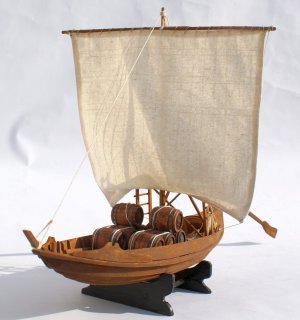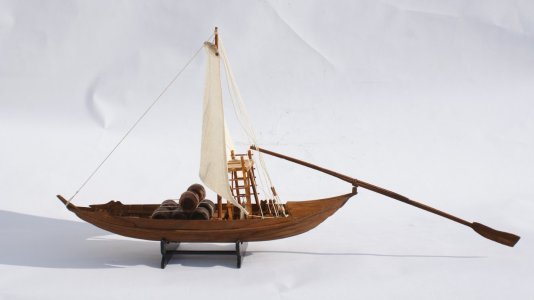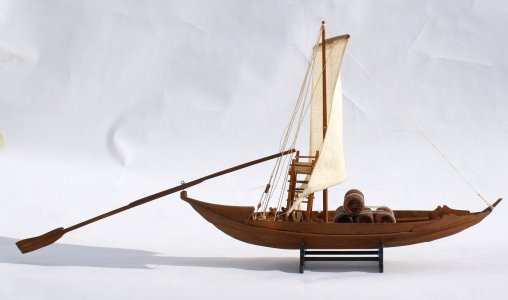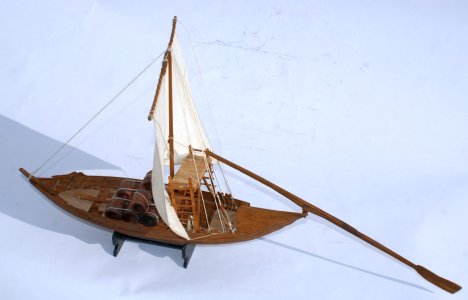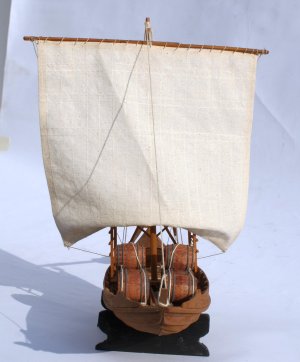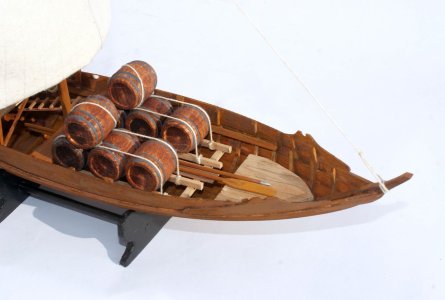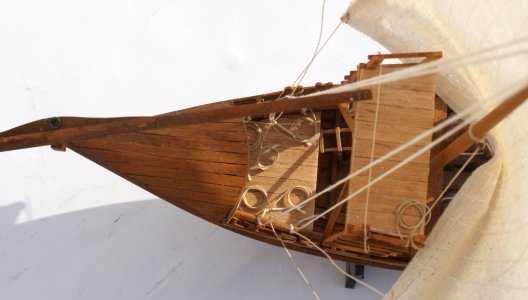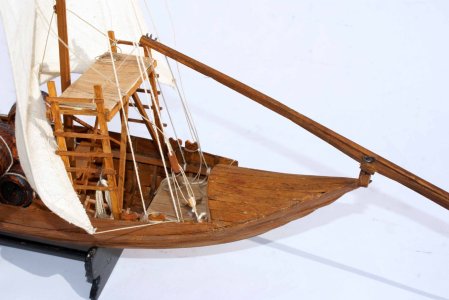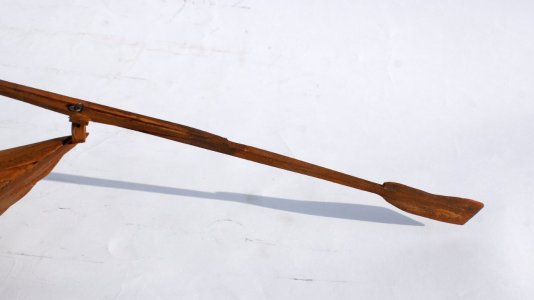Yes!, .., another small boat
RABELO DE OPORTO
1 Preamble
Looking through the magazine Modellbau Heute from July 1987, I liked an article about a boat entitled PORTUGIESISCHES WEINSCHIFF. It showed a boat with a rudder of extreme length; investigating a little further, it turned out that it was a boat commonly called “Rabelo” that transported wine along the Douro River, from the wine-growing areas of Portugal to the city of Porto. The paragraphs in quotation marks have been extracted from the References indicated.
“It was on the banks of the Douro, where the vineyards for the famous Oporto wine were planted. And these were inaccessible, they could only be reached by boat. But it was not an easy path, before the construction of the dams, the strong and fast current dominated this river. Only a boat with a special design could face these conditions and carry the wine. Thus the Rabelo boat was born. The grapes left the vineyards in the Alto Douro area, and once transformed into wine, they continued in pipes along the Douro River in the Rabelo boats to the well-known wineries of Vila Nova de Gaia, in Porto, where they were stored and later sold throughout the world.”
“Currently, they have a different use. Rabelos are used in the famous São João regatta, during the popular festivals of the city of Oporto, for tourist trips along the Douro River and other initiatives.”
“The Rabelo boat began to have a well-defined identity from 1792, when the “Companhia Geral da Agricultura das Vinhas do Alto Douro” published the licenses and other documents that related to the notable Pombaline institution. In this publication, commonly known as “Leis da Companhia”, there is valuable information regarding both the boat and its crew, as well as the traffic for which they were destined.”
“With a flat bottom, the hull is made up of straight planks in a rickety arrangement. These are the special characteristics that make it suitable for a mountain river, such as the Douro. It measures between 19 and 23 meters in length and 4.5 meters wide. Its characteristic sail is square and the first boats only had one mast. Later in history, a second mast was used at the bow. At the stern, a long oar called a spadela steers the boat.
“At that time, a Rabelo boat could have up to seven men in its crew. Two people were in charge of the sheet (which regulates the angle of the sail and controls the incidence of the wind on it), two of the yard (wood perpendicular to the mast, which serves to hold the sail), one man was in charge of the rudder or spadela, and one man was in charge of the bow to control the path.”
2 References
„PORTUGIESISCHES WEINSCHIFF” Dieter Johansson, Modellbau Heute 07-1983

 es.wikipedia.org
es.wikipedia.org

 bluscus.es
bluscus.es
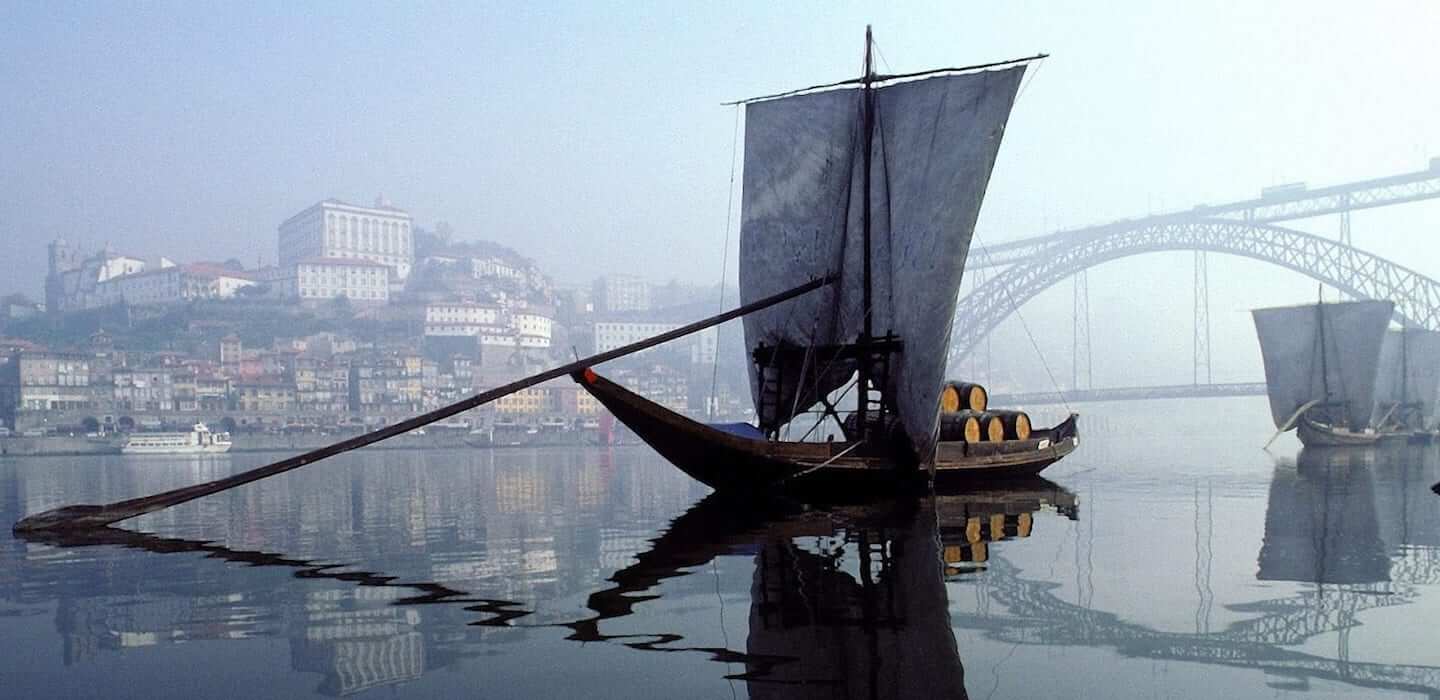
 portoalities.com
portoalities.com

 www.visitportugal.com
www.visitportugal.com
3 Construction of the Model
Initially I had the plans found in Modellbau Heute, which gave me a general idea of the boat, but later I found other plans (freely available) from Rabelos on the Internet with which I complemented the shape of the hull, as well as more precise dimensions of the sail, the structure and the “espadela”. It was also very helpful to watch the 1990s film “Arquitectura de Rabelo” many times, which shows in great detail the construction of a Ravelo from the placement of the bottom to its maiden voyage. I was very struck by the hull construction in a shed, in which each section of the hull is made up of three straight planks without bending in the larger plane, so the excess must be cut off. Because of this way of its construction, the hull is “rough” and does not have very fluid shapes, but we must bear in mind that this was a work boat and worked very well for the conditions of the Duoro River.
Due to the open shape of the hull and the raised ends of the bow and stern, the usual construction method of false keel and frames was not feasible, so it was decided to follow the procedure for building a real Rabelo, that is, first build the bottom and then the hull and then place the frames.
From the “water lines” plan, I prepared a hull mould using balsa wood, taking care of the shape of the bottom, on which I placed the bottom of the boat itself, made up of 1x6 mm pieces. I carved the ends of the mould into the mould to accommodate the stem and sternpost, and began to form the first section of the hull with three straight “boards” 12 mm wide, I cut off the excess to maintain the shape of the bottom and continued to assemble the hull, in a rickety frame and always with three boards for each section, forcing at the ends to achieve the characteristic profile of the boat.
Once finished, it was sanded and we began to place the frames in a vertical position every 11 mm, with the three or four outer frames being positioned at an angle. The excess of the frames was cut and the longitudinal reinforcements of 2x3 mm were mounted along the edge of the last strake, both externally (belt) and internally. The unique curved roof leading to the stern is prepared and we place the upper reinforcements or extensions of certain frames in a vertical position and the corresponding bow which is a 1x12mm piece cut at its lower part to accommodate the shape of the hull.
The mast support is prepared, as well as the fastening element, which is a 2x12 mm plank that rests on the reinforcement and inner hull. So we already have the main part of the boat ready to be sanded. To give it the appearance of a work boat, it will not be puttyed and we will only use fine sandpaper following the strakes and taking care not to lose the hull's rick shape. Next, we will prepare the other parts of the boat or minor elements that have very special characteristics and have been taken to scale from the same plans.
The following were prepared: (a) the decks and the helmsman's platform, with 0.5x6 mm veneer elements treated with a little Judea bitumen to resemble very used elements. (b) the support structure that rises almost 4 meters (65 mm) above the bottom of the boat and is made up of 2x3 and 2x2 mm pieces, has the characteristic that it is inclined 5 degrees towards the bow. (c) the rudder or „spadela“ which is a very unique element, not only because of its length of almost 16 meters (262 mm), but also because of the various shapes of its cross section. (d) the support for the wine barrels made up of pieces of 2x3 and 3x3 mm spaced to facilitate the support and mooring of the barrels. (e) the mast of 218 mm and the yard made up of two pieces giving them the usual sag. (f) The 165x175 mm sail with a piece of cotton, a remnant of a larger boat that does not have its sails. (g) other elements such as the barrels and bucket (acquired), an oar, a ladder among others,
All the wooden elements were stained with walnut color diluted 50% in alcohol, after drying many whitish stains were observed (caused by cyanoacrylate), knowing that there is no way to solve it, I chose to hide these stains with a light layer of brown paint, which I then uniformized throughout the hull externally and internally, giving it a used appearance.
The assembly of the only sail began by tying it to the yard which hangs from the end of the mast, passing through it the ropes of different caliber, clear or raw color of 0.7 mm for the shrouds and forestay; 0.5 mm for the sheets and yard direction. The knots and the tying system of all the elements are very simple. In this last part the photos of the finished Rabelo are presented.
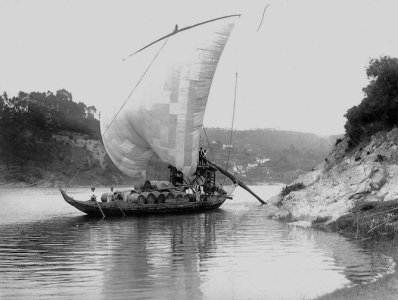

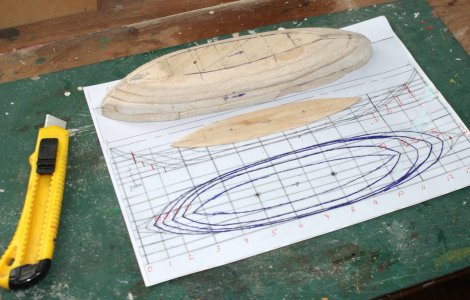
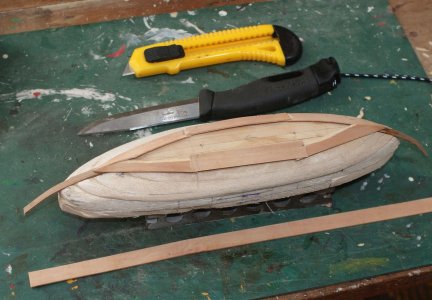
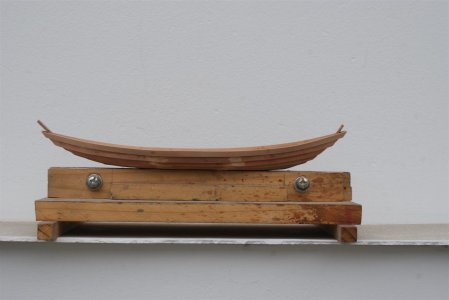
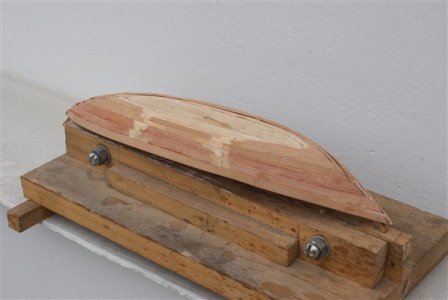
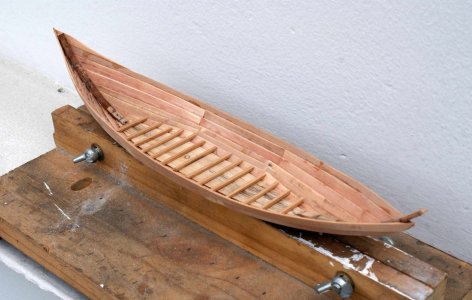
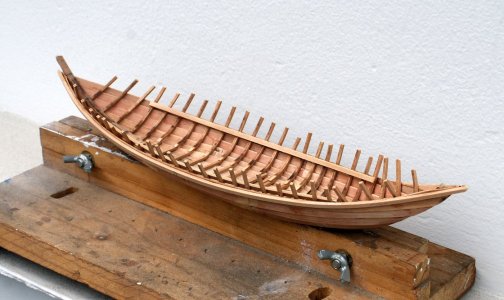
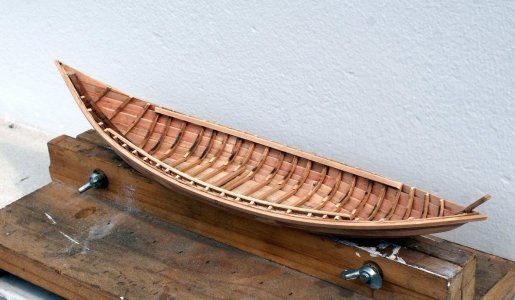
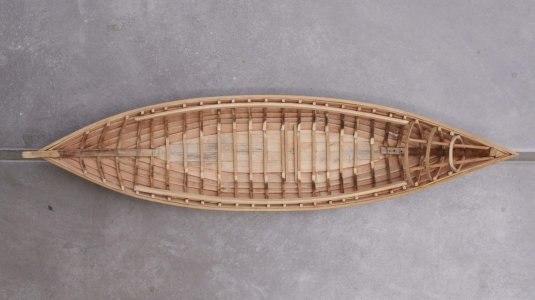
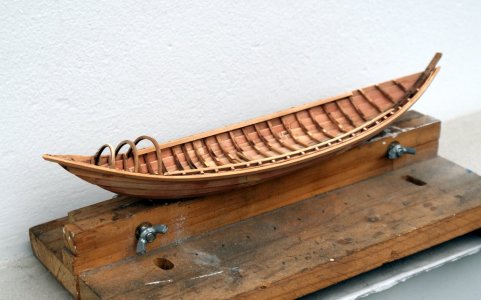
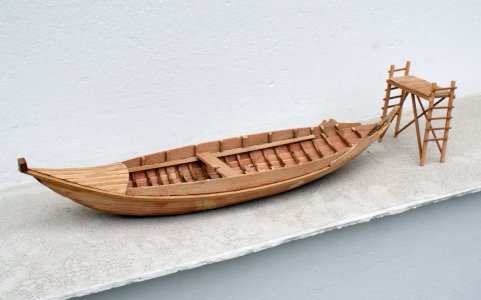
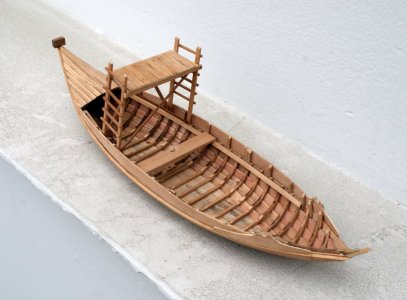
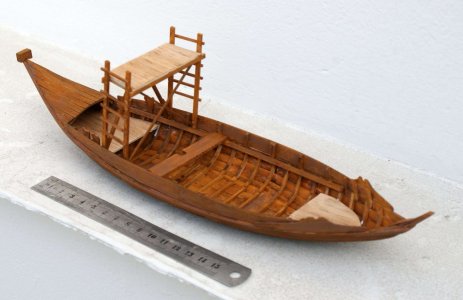

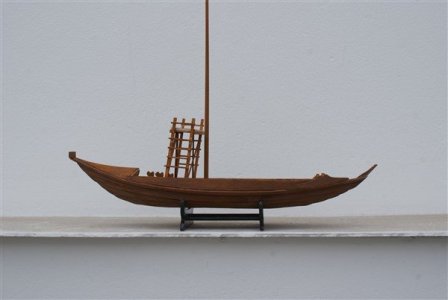
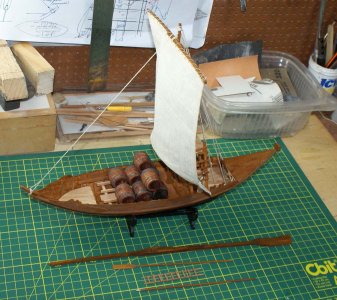
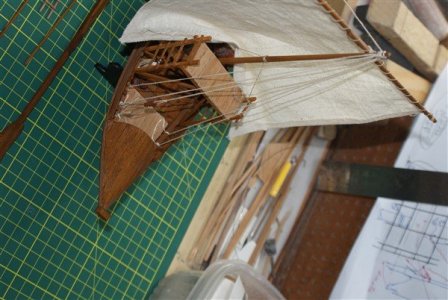
RABELO DE OPORTO
1 Preamble
Looking through the magazine Modellbau Heute from July 1987, I liked an article about a boat entitled PORTUGIESISCHES WEINSCHIFF. It showed a boat with a rudder of extreme length; investigating a little further, it turned out that it was a boat commonly called “Rabelo” that transported wine along the Douro River, from the wine-growing areas of Portugal to the city of Porto. The paragraphs in quotation marks have been extracted from the References indicated.
“It was on the banks of the Douro, where the vineyards for the famous Oporto wine were planted. And these were inaccessible, they could only be reached by boat. But it was not an easy path, before the construction of the dams, the strong and fast current dominated this river. Only a boat with a special design could face these conditions and carry the wine. Thus the Rabelo boat was born. The grapes left the vineyards in the Alto Douro area, and once transformed into wine, they continued in pipes along the Douro River in the Rabelo boats to the well-known wineries of Vila Nova de Gaia, in Porto, where they were stored and later sold throughout the world.”
“Currently, they have a different use. Rabelos are used in the famous São João regatta, during the popular festivals of the city of Oporto, for tourist trips along the Douro River and other initiatives.”
“The Rabelo boat began to have a well-defined identity from 1792, when the “Companhia Geral da Agricultura das Vinhas do Alto Douro” published the licenses and other documents that related to the notable Pombaline institution. In this publication, commonly known as “Leis da Companhia”, there is valuable information regarding both the boat and its crew, as well as the traffic for which they were destined.”
“With a flat bottom, the hull is made up of straight planks in a rickety arrangement. These are the special characteristics that make it suitable for a mountain river, such as the Douro. It measures between 19 and 23 meters in length and 4.5 meters wide. Its characteristic sail is square and the first boats only had one mast. Later in history, a second mast was used at the bow. At the stern, a long oar called a spadela steers the boat.
“At that time, a Rabelo boat could have up to seven men in its crew. Two people were in charge of the sheet (which regulates the angle of the sail and controls the incidence of the wind on it), two of the yard (wood perpendicular to the mast, which serves to hold the sail), one man was in charge of the rudder or spadela, and one man was in charge of the bow to control the path.”
2 References
„PORTUGIESISCHES WEINSCHIFF” Dieter Johansson, Modellbau Heute 07-1983

Barco rabelo - Wikipedia, la enciclopedia libre

Los barcos rabelo: la imagen (de marca) del río Duero » Turismo marinero en Galicia - Bluscus
Os queremos contar la historia de los barcos rabelos en Oporto y su importancia en el desarrollo económico y turístico de la ciudad.

Rabelo Boats and the Douro river cruises in Porto - Portoalities: Travel blog and Private tours in Porto and Douro Valley
Discover the history of the famous rabelo boats and learn about the famous Douro river cruises in Porto and how to take them.

Barco Rabelo | www.visitportugal.com
Varias referencias a este barco demuestran que su existencia se remonta al siglo X.Los "rabelos" fueron especialmente concebidos para el río Duero, antaño de difícil navegación, y para el transporte de barriles de vino. Sus características le permitían navegar con más facilidad y menos riesgo...
3 Construction of the Model
Initially I had the plans found in Modellbau Heute, which gave me a general idea of the boat, but later I found other plans (freely available) from Rabelos on the Internet with which I complemented the shape of the hull, as well as more precise dimensions of the sail, the structure and the “espadela”. It was also very helpful to watch the 1990s film “Arquitectura de Rabelo” many times, which shows in great detail the construction of a Ravelo from the placement of the bottom to its maiden voyage. I was very struck by the hull construction in a shed, in which each section of the hull is made up of three straight planks without bending in the larger plane, so the excess must be cut off. Because of this way of its construction, the hull is “rough” and does not have very fluid shapes, but we must bear in mind that this was a work boat and worked very well for the conditions of the Duoro River.
Due to the open shape of the hull and the raised ends of the bow and stern, the usual construction method of false keel and frames was not feasible, so it was decided to follow the procedure for building a real Rabelo, that is, first build the bottom and then the hull and then place the frames.
From the “water lines” plan, I prepared a hull mould using balsa wood, taking care of the shape of the bottom, on which I placed the bottom of the boat itself, made up of 1x6 mm pieces. I carved the ends of the mould into the mould to accommodate the stem and sternpost, and began to form the first section of the hull with three straight “boards” 12 mm wide, I cut off the excess to maintain the shape of the bottom and continued to assemble the hull, in a rickety frame and always with three boards for each section, forcing at the ends to achieve the characteristic profile of the boat.
Once finished, it was sanded and we began to place the frames in a vertical position every 11 mm, with the three or four outer frames being positioned at an angle. The excess of the frames was cut and the longitudinal reinforcements of 2x3 mm were mounted along the edge of the last strake, both externally (belt) and internally. The unique curved roof leading to the stern is prepared and we place the upper reinforcements or extensions of certain frames in a vertical position and the corresponding bow which is a 1x12mm piece cut at its lower part to accommodate the shape of the hull.
The mast support is prepared, as well as the fastening element, which is a 2x12 mm plank that rests on the reinforcement and inner hull. So we already have the main part of the boat ready to be sanded. To give it the appearance of a work boat, it will not be puttyed and we will only use fine sandpaper following the strakes and taking care not to lose the hull's rick shape. Next, we will prepare the other parts of the boat or minor elements that have very special characteristics and have been taken to scale from the same plans.
The following were prepared: (a) the decks and the helmsman's platform, with 0.5x6 mm veneer elements treated with a little Judea bitumen to resemble very used elements. (b) the support structure that rises almost 4 meters (65 mm) above the bottom of the boat and is made up of 2x3 and 2x2 mm pieces, has the characteristic that it is inclined 5 degrees towards the bow. (c) the rudder or „spadela“ which is a very unique element, not only because of its length of almost 16 meters (262 mm), but also because of the various shapes of its cross section. (d) the support for the wine barrels made up of pieces of 2x3 and 3x3 mm spaced to facilitate the support and mooring of the barrels. (e) the mast of 218 mm and the yard made up of two pieces giving them the usual sag. (f) The 165x175 mm sail with a piece of cotton, a remnant of a larger boat that does not have its sails. (g) other elements such as the barrels and bucket (acquired), an oar, a ladder among others,
All the wooden elements were stained with walnut color diluted 50% in alcohol, after drying many whitish stains were observed (caused by cyanoacrylate), knowing that there is no way to solve it, I chose to hide these stains with a light layer of brown paint, which I then uniformized throughout the hull externally and internally, giving it a used appearance.
The assembly of the only sail began by tying it to the yard which hangs from the end of the mast, passing through it the ropes of different caliber, clear or raw color of 0.7 mm for the shrouds and forestay; 0.5 mm for the sheets and yard direction. The knots and the tying system of all the elements are very simple. In this last part the photos of the finished Rabelo are presented.




















